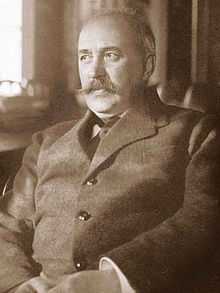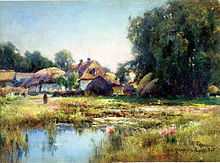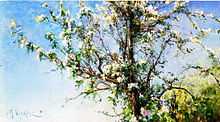Mykhaylo Berkos
| Mykhaylo Berkos | |
|---|---|
 | |
| Born |
September 3, 1861 Odessa |
| Died |
December 20, 1919 (aged 58) Kharkiv |
| Nationality | Russian Empire |
| Education | Imperial Academy of Arts |
| Known for | painting |
| Movement | Impressionism |
Mykhailo Andrіyovich Berkos (Ukrainian: Михайло Андрійович Беркос, 1861, Odessa – 1919, Kharkiv) was a Russian and Ukraine artist of Greek origin.[1] He worked mainly in the genre of landscape art, experienced a significant influence of European Impressionism.[2] He painted in oils and watercolors.[1] In his works he often turned to the subject of Ukrainian nature.[2]
Biography
Berkos was born on September 3, 1861 in Odessa.[3] His father Andrey Ignatievich Berkos, a subject of Greece, served in the firm Bellino Fender, his mother Martha Ivanovna came from a Russian noble family.[4] The family lived in their house on Pushkinskaya.[4]
Mykhailo Berkos first studied painting in Odessa Drawing School, graduating in 1877.[1] Then he continued his education at the Imperial Academy of Arts in Saint Petersburg, where he studied from 1878 to 1889 in the studio of Mikhail Clodt and Volodymyr Orlovsky.[1] He got a small and large silver medals (1884–1886), a small gold medal for the painting View of one of the oldest parks in St. Petersburg (1887), a gold medal for the painting Landscape. Forest in the swamp (1888).[1][3] During the holidays he came to Kharkiv with fellow artists and painted landscapes, in particular sketch Full poppies (1885).[3] In 1889 he graduated from the academy with the rank of first degree class artist and the right to travel abroad at public expense (pension).[3]
From 1890 to 1893 Berkos as a pensioner of the Academy traveled by Europe, studying art of museums in France, Germany, Spain, Italy, Switzerland.[3] He painted a lot, perfected his technique, was influenced by Impressionism and en plein air painting.[3] After the expiration of pension Berkos some time lived in St. Petersburg and presented his paintings at exhibitions of societies of artists.[1][3]

In the second half of the 1890s he moved to Kharkiv.[3] He lived in a suburb of Mala Danylivka with the General's widow Maria Reinicke.[4] There he wrote sketches, among which Greenhouses (1895) and Landscape with a Church (1897) have survived.[3] From 1904 he taught at the school of drawing in Kharkiv.[1]
At the initiative of Berkos in 1912 the Kharkiv Art College was opened, where until 1917 he was one of the leading teachers.[4] Berkos put a lot of effort to enrich the collection of the first Museum of Art and Industry in Ukraine.[4] In the early 1900s he worked at the Kharkiv literary and artistic section.[4] As the chairman of the Society of Kharkiv Artists since 1906 he spent a great job of promoting Ukrainian art.[3] In 1907 he participated in the interiors decoration of the Poltava Zemstvo building in the Ukrainian Nouveau style.[3]
In 1900 he was exhibited at the Exposition Universelle in Paris.[1] Solo exhibitions of Berkos took place in 1906 and 1908 in Kharkiv, there also was an exhibition of works by Kharkiv artists Serhii Vasylkivsky and Mykhaylo Berkos in 1911 in Kiev.[4] He died of typhus on December 20, 1919 in Kharkiv.[3][4]
Exhibitions
.jpg)
Works of Berkos were presented at exhibitions-competitions and exhibitions-sales of the Academy of Arts (1890, 1892–1894), St. Petersburg Society of Artists (1894–1903), societies of Russian watercolors (1894–1898, 1900–1905, 1907, 1910, 1914), southern Russian artists, Kharkiv painters (1893, 1894, 1912, 1914–1917), the All-Russia exhibition in Nizhny Novgorod (1896), the Exposition Universelle in Paris (1900).[3]
Intravital solo exhibitions of the artist were organized in 1906 and 1908 (Kharkiv Art and Industry Museum), there also was an exhibition of paintings by Serhii Vasylkivsky and Mykhaylo Berkos in 1911 in Kiev.[3]
In October 1938 the Kharkiv National Gallery exhibited about 120 paintings created by the artist in the years 1890–1919. Exhibitions of his paintings were also held in the Kharkiv Art Museum in 1962, 1990 and 1996. The exhibition Outstanding Ukrainian landscape masters in 1990 presented 28 paintings and three drawings from the museum and private collections.[3]
Artworks

Almost all of the works of Berkos which were stored at his home (350 paintings and sketches) after his death were burned by his wife.[3][4] However, his works have been preserved in museum collections in Kharkiv, Kiev, Moscow, St. Petersburg, Ulyanovsk, Stavropol, Alupka, North Ossetia, Germany, France and Switzerland.[3]
The main theme of the artist's art throughout his career was a Ukrainian landscape, the specific features of nature, the nature of vegetation.[3] Berkos loved to paint during blossoming. Village streets with white houses and lush trees, flowering fields of flax and buckwheat were his favorite motifs: paintings Flax in bloom (1893), Buckwheat in bloom (1894), July. Poppies are blooming (1913), Apple tree in bloom (1919). His sketches Full poppies (1885), The Valley, Flax (1893) noted completeness, reasonableness of the composition, the freshness of color, special refinement.[3]
Landscapes Rome and Sorrento (1899) take the romantic coloring of past times by the reproduction of pure blue sky, bright sunshine, rich color shades of green tall trees, flowing enamel-like painting. Sketch Haven. Amalfi (1899) was depicted in light improvisational manner, it’s an elegant painting, impregnated with a dynamic movement.[3]
The color structure of the landscape Winter (1907), painted in the Poltava region, was designed in blue and white palette with flashes of pink with elaborate decorative. In his landscapes the display of the usual corner, above all Sloboda Ukraine, turns into a generalized image of Ukraine. In his work Street in Uman (1895) the picture of a provincial Ukrainian town, its dusty roads, winding streets, ramshackle houses and domes of the churches were reflected with high authenticity.[3]
Literature
- Енциклопедія українознавства. У 10-х томах. / Головний редактор Володимир Кубійович. — Париж; Нью-Йорк: Молоде життя, 1954—1989.
- М. А. Беркос. С. М. Ткаченко. П. О. Левченко. Живопис, графіка. Каталог. — Харків, 1991.
- Харківська пейзажна школа: остання чверть ХІХ — початок ХХ століття. — Київ: «Родовід», 2009.
References
| Wikimedia Commons has media related to Mykhaylo Berkos. |
- ↑ 1.0 1.1 1.2 1.3 1.4 1.5 1.6 1.7 Беркос Михаил Андреевич (in Russian). Артпоиск. Retrieved 2012-06-09.
- ↑ 2.0 2.1 Михайло Беркос. Українці в світі (in Ukrainian). Retrieved 2012-06-09.
- ↑ 3.0 3.1 3.2 3.3 3.4 3.5 3.6 3.7 3.8 3.9 3.10 3.11 3.12 3.13 3.14 3.15 3.16 3.17 3.18 3.19 3.20 Г. М. Єрофєєва (2006). Художник квітучої природи (до 145-річчя з дня народження М. А. Беркоса) (in Ukrainian). Харківська обласна універсальна наукова бібліотека. Retrieved 2012-06-09.
- ↑ 4.0 4.1 4.2 4.3 4.4 4.5 4.6 4.7 4.8 Олена Узбек (2010-03-12). Майстер Беркос у світі любові і смутку (in Ukrainian). Голос України. Retrieved 2012-06-09.